#wu chien-ho
Text

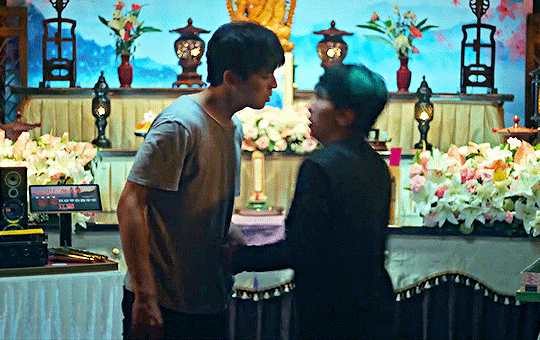




My boyfriend asked me to punch him in the face* and you'll never guess what happened next!
*he punched me first
Wu Chien-Ho and JC Lin in LET'S TALK ABOUT CHU (2024) episode 7
#jc lin#wu chien-ho#let's talk about chu#asianlgbtqdramas#gay#taiwanese drama#twdrama#bldramaedit#kinda of?#they are a dream#seriously their archetypes are sooo good#who would've thought funerals were so much fun in Taiwan
182 notes
·
View notes
Text
Đời vốn đầy chông gai. Tháng trước, tôi đã tổ chức tang lễ cho con trai mình. Tôi cũng đã cố bình tĩnh lại và tiếp tục hướng dẫn các bạn. Cuộc sống là phải nắm bắt thời gian và quyết định phương hướng của mình. Mọi chuyện đau thương đều sẽ trôi qua và bị lãng quên.
Tôi đã luôn nghĩ rằng đời là một chặng đường. Chừng nào các bạn còn giữ chặt tay lái, dừng khi thấy đèn đỏ, tăng tốc từ từ khi có đèn xanh, và lái xe vững vàng, thì chặng đường đời sẽ suôn sẻ và vững chãi.

- A Văn, người cha | The Sun
#quotes#movie quotes#a sun#陽光普照#Chung Mong-hong#Samantha Ko#Greg Hsu#Wen Cheng-ling#Chen Yi-wen#Wu Chien-ho#Chang Yao-sheng#Lai Hsiu-hsiung#Lin Sheng-xiang#movies
0 notes
Text

Got interested because of Kai Ko, stayed for these two.
59 notes
·
View notes
Text



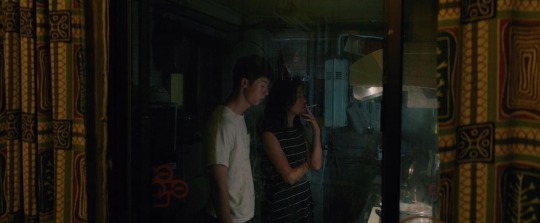

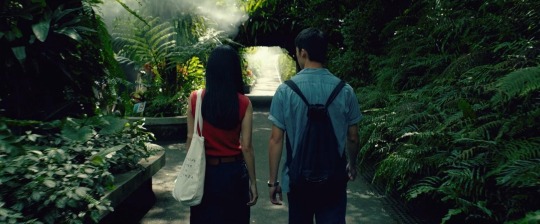



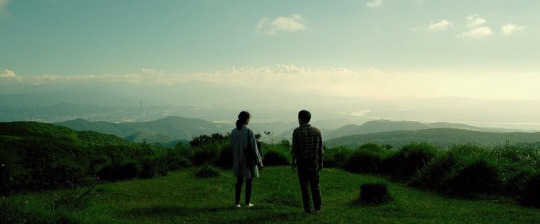
A Sun (2019)
Dir. Chung Mong-hong
#a sun#taiwan#taiwanese film#Asian film#east asia#East Asian film#Ching mong-hong#yi-wen chen#shu-chin ko#chien-ho wu#greg hsu#family#drama
12 notes
·
View notes
Text
MOVIE REVIEW | A Sun (2019)

Taiwanese director Chung Mong-Hong delivers one of the most beautifully sorrowful films I have seen in my life. Using a color palette of blues and yellows, it tells the story of a family forced to rebuild in the face of multiples tragedies.
In addition the film questions whether people are capable of change, as well as whether we can change people’s impressions of us.
Chung’s unforgettable family drama promises both to devastate and uplift audiences in any country where this masterpiece stands a chance at being released.
1 note
·
View note
Text
RACCORD: EL SOL QUE ABRASA
En mayo de 1801 “El último hombre que lo sabía todo”, Thomas Young, para retar la teoría corpuscular de Newton ideó un experimento: hizo pasar un haz de luz por dos rendijas y vio que sobre una pantalla se producía una serie de franjas brillantes y oscuras alternadas… un patrón de interferencia. La interferencia se produce cuando dos o más ondas se superponen para formar otra de mayor o menor…
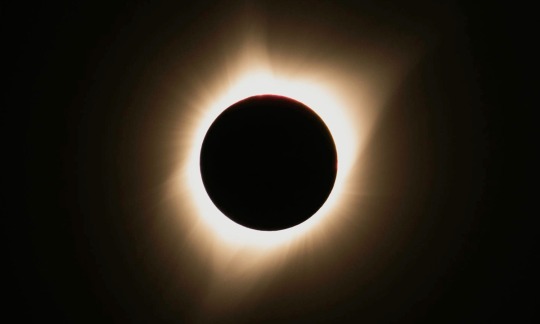
View On WordPress
#Chien–Ho Wu#Chung Mong–Hong#Cine#Difracción#El experimento de la doble rejilla#El experimento más bello de la historia#Física#Greg Han Hsu#Hijos#Interferencia#Luz#Obscuridad#Padre#Raccord#Redención#Suicidio#Thomas Young
0 notes
Text
List of Gods, most of which are no longer worshipped. via /r/atheism
List of Gods, most of which are no longer worshipped.
Middle-East
A, Adad, Adapa, Adrammelech, Aeon, Agasaya, Aglibol, Ahriman, Ahura Mazda, Ahurani, Ai-ada, Al-Lat, Aja, Aka, Alalu, Al-Lat, Amm, Al-Uzza (El-'Ozza or Han-Uzzai), An, Anahita, Anath (Anat), Anatu, Anbay, Anshar, Anu, Anunitu, An-Zu, Apsu, Aqhat, Ararat, Arinna, Asherali, Ashnan, Ashtoreth, Ashur, Astarte, Atar, Athirat, Athtart, Attis, Aya, Baal (Bel), Baalat (Ba'Alat), Baau, Basamum, Beelsamin, Belit-Seri, Beruth, Borak, Broxa, Caelestis, Cassios, Lebanon, Antilebanon, and Brathy, Chaos, Chemosh, Cotys, Cybele, Daena, Daevas, Dagon, Damkina, Dazimus, Derketo, Dhat-Badan, Dilmun, Dumuzi (Du'uzu), Duttur, Ea, El, Endukugga, Enki, Enlil, Ennugi, Eriskegal, Ereshkigal (Allatu), Eshara, Eshmun, Firanak, Fravashi, Gatamdug, Genea, Genos, Gestinanna, Gula, Hadad, Hannahanna, Hatti, Hea, Hiribi, The Houri, Humban, Innana, Ishkur, Ishtar, Ithm, Jamshid or Jamshyd, Jehovah, Jesus, Kabta, Kadi, Kamrusepas, Ki (Kiki), Kingu, Kolpia, Kothar-u-Khasis, Lahar, Marduk, Mari, Meni, Merodach, Misor, Moloch, Mot, Mushdama, Mylitta, Naamah, Nabu (Nebo), Nairyosangha, Nammu, Namtaru, Nanna, Nebo, Nergal, Nidaba, Ninhursag or Nintu, Ninlil, Ninsar, Nintur, Ninurta, Pa, Qadshu, Rapithwin, Resheph (Mikal or Mekal), Rimmon, Sadarnuna, Shahar, Shalim, Shamish, Shapshu, Sheger, Sin, Siris (Sirah), Taautos, Tammuz, Tanit, Taru, Tasimmet, Telipinu, Tiamat, Tishtrya, Tsehub, Utnapishtim, Utu, Wurusemu, Yam, Yarih (Yarikh), Yima, Zaba, Zababa, Zam, Zanahary (Zanaharibe), Zarpandit, Zarathustra, Zatavu, Zazavavindrano, Ziusudra, Zu (Imdugud), Zurvan
China:
Ba, Caishen, Chang Fei, Chang Hsien, Chang Pan, Ch'ang Tsai, Chao san-Niang, Chao T'eng-k'ang, Chen Kao, Ch'eng Huang, Cheng San-Kung, Cheng Yuan-ho, Chi Po, Chien-Ti, Chih Jih, Chih Nii, Chih Nu, Ch'ih Sung-tzu, Ching Ling Tzu, Ch'ing Lung, Chin-hua Niang-niang, Chio Yuan-Tzu, Chou Wang, Chu Niao, Chu Ying, Chuang-Mu, Chu-jung, Chun T'i, Ch'ung Ling-yu, Chung Liu, Chung-kuei, Chung-li Ch'üan, Di Jun, Fan K'uei, Fei Lien, Feng Pho-Pho, Fengbo, Fu Hsing, Fu-Hsi, Fu-Pao, Gaomei, Guan Di, Hao Ch'iu, Heng-o, Ho Po (Ping-I), Hou Chi, Hou T'u, Hsi Ling-su, Hsi Shih, Hsi Wang Mu, Hsiao Wu, Hsieh T'ien-chun, Hsien Nung, Hsi-shen, Hsu Ch'ang, Hsuan Wen-hua, Huang Ti, Huang T'ing, Huo Pu, Hu-Shen, Jen An, Jizo Bosatsu, Keng Yen-cheng, King Wan, Ko Hsien-Weng, Kuan Ti, Kuan Ti, Kuei-ku Tzu, Kuo Tzu-i, Lai Cho, Lao Lang, Lei Kung, Lei Tsu, Li Lao-chun, Li Tien, Liu Meng, Liu Pei, Lo Shen, Lo Yu, Lo-Tsu Ta-Hsien, Lu Hsing, Lung Yen, Lu-pan, Ma-Ku, Mang Chin-i, Mang Shen, Mao Meng, Men Shen, Miao Hu, Mi-lo Fo, Ming Shang, Nan-chi Hsien-weng, Niu Wang, Nu Wa, Nu-kua, Pa, Pa Cha, Pai Chung, Pai Liu-Fang, Pai Yu, P'an Niang, P'an-Chin-Lien, Pao Yuan-ch'uan, Phan Ku, P'i Chia-Ma, Pien Ho, San Kuan, Sao-ch'ing Niang, Sarudahiko, Shang Chien, Shang Ti, She chi, Shen Hsui-Chih, Shen Nung, Sheng Mu, Shih Liang, Shiu Fang, Shou-lao, Shun I Fu-jen, Sien-Tsang, Ssu-ma Hsiang-ju, Sun Pin, Sun Ssu-miao, Sung-Chiang, Tan Chu, T'ang Ming Huang, Tao Kung, T'ien Fei, Tien Hou, Tien Mu, Ti-tsang, Tsai Shen, Ts'an Nu, Ts'ang Chien, Tsao Chun, Tsao-Wang, T'shai-Shen, Tung Chun, T'ung Chung-chung, T'ung Lai-yu, Tung Lu, T'ung Ming, Tzu-ku Shen, Wa, Wang Ta-hsien, Wang-Mu-Niang-Niang, Weiwobo, Wen-ch'ang, Wu-tai Yuan-shuai, Xi Hou, Xi Wangmu, Xiu Wenyin, Yanwang, Yaoji, Yen-lo, Yen-Lo-Wang, Yi, Yu, Yu Ch'iang, Yu Huang, Yun-T'ung, Yu-Tzu, Zaoshen, Zhang Xi, , Zhinü, , Zhongguei, , Zigu Shen, , Zisun, Ch'ang-O
Slavic:
Aba-khatun, Aigiarm, Ajysyt, Alkonost, Almoshi, Altan-Telgey, Ama, Anapel, As-ava, Ausaitis, Austeja, Ayt'ar, Baba Yaga (Jezi Baba), Belobog (Belun), Boldogasszony, Breksta, Bugady Musun, Chernobog (Crnobog, Czarnobog, Czerneboch, Cernobog), Cinei-new, Colleda (Koliada), Cuvto-ava, Dali, Darzu-mate, Dazhbog, Debena, Devana, Diiwica (Dilwica), Doda (Dodola), Dolya, Dragoni, Dugnai, Dunne Enin, Edji, Elena, Erce, Etugen, Falvara, The Fates, The Fatit, Gabija, Ganiklis, Giltine, Hotogov Mailgan, Hov-ava, Iarila, Isten, Ja-neb'a, Jedza, Joda-mate, Kaldas, Kaltes, Keretkun, Khadau, Khursun (Khors), Kostrubonko, Kovas, Krumine, Kupala, Kupalo, Laima, Leshy, Marina, Marzana, Matergabiae, Mat Syra Zemlya, Medeine, Menu (Menulis), Mir-Susne-Khum, Myesyats, Nastasija, (Russia) Goddess of sleep., Nelaima, Norov, Numi-Tarem, Nyia, Ora, Ot, Patollo, Patrimpas, Pereplut, Perkuno, Perun, Pikuolis, Pilnytis, Piluitus, Potrimpo, Puskaitis, Rod, Rugevit, Rultennin, Rusalki, Sakhadai-Noin, Saule, Semargl, Stribog, Sudjaje, Svantovit (Svantevit, Svitovyd), Svarazic (Svarozic, Svarogich), Tengri, Tñairgin, Triglav, Ulgen (Ulgan, Ülgön), Veles (Volos), Vesna, Xatel-Ekwa, Xoli-Kaltes, Yamm, Yarilo, Yarovit, Ynakhsyt, Zaria, Zeme mate, Zemyna, Ziva (Siva), Zizilia, Zonget, Zorya, Zvoruna, Zvezda Dennitsa, Zywie
Hindu
Aditi, Adityas, Ambika, Ananta (Shesha), Annapurna (Annapatni), Aruna, Ashvins, Balarama, Bhairavi, Brahma, Buddha, Dakini, Devi, Dharma, Dhisana, Durga, Dyaus, Ganesa (Ganesha), Ganga (Ganges), Garuda, Gauri, Gopis, Hanuman, Hari-Hara, Hulka Devi, Jagganath, Jyeshtha, Kama, Karttikeya, Krishna, Krtya, Kubera, Kubjika, Lakshmi or Laksmi, Manasha, Manu, Maya, Meru, Nagas, Nandi, Naraka, Nataraja, Nirriti, Parjanya, Parvati, Paurnamasi, Prithivi, Purusha, Radha, Rati, Ratri, Rudra, Sanjna, Sati, Shashti, Shatala, Sitala (Satala), Skanda, Sunrta, Surya, Svasti-devi, Tvashtar, Uma, Urjani, Vach, Varuna, Vayu, Vishnu (Avatars of Vishnu: Matsya; Kurma; Varaha; Narasinha; Vamana; Parasurama; Rama; Krishna; Buddha; Kalki), Vishvakarman, Yama, Sraddha
Japan: Aji-Suki-Taka-Hi-Kone, Ama no Uzume, Ama-terasu, Amatsu Mikaboshi, Benten (Benzai-Ten), Bishamon, Chimata-No-Kami, Chup-Kamui, Daikoku, Ebisu, Emma-O, Fudo, Fuji, Fukurokuju, Gekka-O, Hachiman, Hettsui-No-Kami, Ho-Masubi, Hotei, Inari, Izanagi and Izanami, Jizo Bosatsu, Jurojin, Kagutsuchi, Kamado-No-Kami, Kami, Kawa-No-Kami, Kaya-Nu-Hima, Kishijoten, Kishi-Mojin, Kunitokotatchi, Marici, Monju-Bosatsu, Nai-No-Kami, No-Il Ja-Dae, O-Kuni-Nushi, Omoigane, Raiden, Shine-Tsu-Hiko, Shoten, Susa-no-wo, Tajika-no-mikoto, Tsuki-yomi, Uka no Mitanna, Uke-mochi, Uso-dori, Uzume, Wakahirume, Yainato-Hnneno-Mikoi, Yama-No-Kami, Yama-no-Karni, Yaya-Zakurai, Yuki-Onne
India
Agni, Ammavaru, Asuras, Banka-Mundi, Brihaspati, Budhi Pallien, Candi, Challalamma, Chinnintamma, Devas, Dyaush, Gauri-Sankar, Grhadevi, Gujeswari, Indra, Kali, Lohasur Devi, Mayavel, Mitra, Prajapati, Puchan, Purandhi, Rakshas, Rudrani, Rumina, Samundra, Sarasvati, Savitar, Siva (Shiva), Soma, Sura, Surabhi, Tulsi, Ushas, Vata, Visvamitra, Vivasvat, Vritra, Waghai Devi, Yaparamma, Yayu, Zumiang Nui, Diti
Other Asian: Dewi Shri, Po Yan Dari, Shuzanghu, Antaboga, Yakushi Nyorai, Mulhalmoni, Tankun, Yondung Halmoni, Aryong Jong, Quan Yin , Tengri, Uminai-gami, Kamado-No-Kami, Kunitokotatchi, Giri Devi, Dewi Nawang Sasih, Brag-srin-mo, Samanta-Bhadra, Sangs-rgyas-mkhá, Sengdroma, Sgeg-mo-ma, Tho-og, Ui Tango, Yum-chen-mo, Zas-ster-ma-dmar-mo, Chandra, Dyaus, Ratri, Rodasi, Vayu, Au-Co
African Gods, Demigods and First Men:
Abassi , Abuk , Adu Ogyinae , Agé , Agwe , Aida Wedo , Ajalamo, Aje, Ajok, Akonadi, Akongo, Akuj, Amma, Anansi, Asase Yaa, Ashiakle, Atai , Ayaba, Aziri, Baatsi, Bayanni, Bele Alua, Bomo rambi, Bosumabla, Buk, Buku, Bumba, Bunzi, Buruku, Cagn, Candit, Cghene, Coti, Damballah-Wedo, Dan, Deng, Domfe, Dongo, Edinkira, Efé, Egungun-oya, Eka Abassi, Elephant Girl Mbombe, Emayian, Enekpe, En-Kai, Eseasar, Eshu, Esu, Fa, Faran, Faro, Fatouma, Fidi Mukullu, Fon, Gleti, Gonzuole, Gû, Gua, Gulu, Gunab, Hammadi, Hêbiesso, Iku, Ilankaka, Imana, Iruwa, Isaywa, Juok, Kazooba, Khakaba, Khonvum, Kibuka, Kintu, Lebé, Leza, Libanza, Lituolone, Loko, Marwe, Massim Biambe, Mawu-Lisa (Leza), Mboze, Mebeli, Minepa, Moombi, Mukameiguru, Mukasa, Muluku, Mulungu, Mwambu, Nai, Nambi, Nana Buluku, Nanan-Bouclou, Nenaunir, Ng Ai, Nyaliep, Nyambé, Nyankopon, Nyasaye, Nzame, Oboto, Obumo, Odudua-Orishala, Ogun, Olokun, Olorun, Orisha Nla, Orunmila, Osanyin, Oshe, Osun, Oya, Phebele, Pokot-Suk, Ralubumbha, Rugaba, Ruhanga, Ryangombe, Sagbata, Shagpona, Shango, Sopona, Tano, Thixo, Tilo, Tokoloshi, Tsui, Tsui'goab, Umvelinqangi, Unkulunkulu, Utixo, Wak, Wamara, Wantu Su, Wele, Were, Woto, Xevioso, Yangombi, Yemonja, Ymoa, Ymoja, Yoruba, Zambi, Zanahary , Zinkibaru
Australian Gods, Goddesses and Places in the Dreamtime:
Alinga, Anjea, Apunga, Arahuta, Ariki, Arohirohi, Bamapana, Banaitja, Bara, Barraiya, Biame, Bila, Boaliri, Bobbi-bobbi, Bunbulama, Bunjil, Cunnembeille, Daramulum, Dilga, Djanggawul Sisters, Eingana, Erathipa, Gidja , Gnowee, Haumia, Hine Titama, Ingridi, Julana, Julunggul, Junkgowa, Karora, Kunapipi-Kalwadi-Kadjara, Lia, Madalait, Makara, Nabudi, Palpinkalare, Papa, Rangi, Rongo, Tane, Tangaroa, Tawhiri-ma-tea, Tomituka, Tu, Ungamilia, Walo, Waramurungundi, Wati Kutjarra, Wawalag Sisters, Wuluwaid, Wuragag, Wuriupranili, Wurrunna, Yhi
Buddhism, Gods and Relatives of God:
Aizen-Myoo, Ajima,Dai-itoku-Myoo, Fudo-Myoo, Gozanze-Myoo, Gundari-Myoo, Hariti, Kongo-Myoo, Kujaku-Myoo, Ni-O
Carribean: Gods, Monsters and Vodun Spirits
Agaman Nibo , Agwe, Agweta, Ah Uaynih, Aida Wedo , Atabei , Ayida , Ayizan, Azacca, Baron Samedi, Ulrich, Ellegua, Ogun, Ochosi, Chango, Itaba, Amelia, Christalline, Clairmé, Clairmeziné, Coatrischie, Damballah , Emanjah, Erzuli, Erzulie, Ezili, Ghede, Guabancex, Guabonito, Guamaonocon, Imanje, Karous, Laloue-diji, Legba, Loa, Loco, Maitresse Amelia , Mapiangueh, Marie-aimée, Marinette, Mombu, Marassa, Nana Buruku, Oba, Obtala, Ochu, Ochumare, Oddudua, Ogoun, Olokum, Olosa, Oshun, Oya, Philomena, Sirêne, The Diablesse, Itaba, Tsilah, Ursule, Vierge, Yemaya , Zaka
Celtic: Gods, Goddesses, Divine Kings and Pagan Saints
Abarta, Abna, Abnoba, Aine, Airetech,Akonadi, Amaethon, Ameathon, An Cailleach, Andraste, Antenociticus, Aranrhod, Arawn, Arianrod, Artio, Badb,Balor, Banbha, Becuma, Belatucadros, Belatu-Cadros, Belenus, Beli,Belimawr, Belinus, Bendigeidfran, Bile, Blathnat, Blodeuwedd, Boann, Bodus,Bormanus, Borvo, Bran, Branwen, Bres, Brigid, Brigit, Caridwen, Carpantus,Cathbadh, Cecht, Cernach, Cernunnos, Cliodna, Cocidius, Conchobar, Condatis, Cormac,Coronus,Cosunea, Coventina, Crarus,Creidhne, Creirwy, Cu Chulainn, Cu roi, Cuda, Cuill,Cyhiraeth,Dagda, Damona, Dana, Danu, D'Aulnoy,Dea Artio, Deirdre , Dewi, Dian, Diancecht, Dis Pater, Donn, Dwyn, Dylan, Dywel,Efnisien, Elatha, Epona, Eriu, Esos, Esus, Eurymedon,Fedelma, Fergus, Finn, Fodla, Goewyn, Gog, Goibhniu, Govannon , Grainne, Greine,Gwydion, Gwynn ap Nudd, Herne, Hu'Gadarn, Keltoi,Keridwen, Kernunnos,Ler, Lir, Lleu Llaw Gyffes, Lludd, Llyr, Llywy, Luchta, Lug, Lugh,Lugus, Mabinogion,Mabon, Mac Da Tho, Macha, Magog, Manannan, Manawydan, Maponos, Math, Math Ap Mathonwy, Medb, Moccos,Modron, Mogons, Morrig, Morrigan, Nabon,Nantosuelta, Naoise, Nechtan, Nedoledius,Nehalennia, Nemhain, Net,Nisien, Nodens, Noisi, Nuada, Nwywre,Oengus, Ogma, Ogmios, Oisin, Pach,Partholon, Penard Dun, Pryderi, Pwyll, Rhiannon, Rosmerta, Samhain, Segidaiacus, Sirona, Sucellus, Sulis, Taliesin, Taranis, Teutates, The Horned One,The Hunt, Treveni,Tyne, Urien, Ursula of the Silver Host, Vellaunus, Vitiris, White Lady
Egyptian: Gods, Gods Incarnate and Personified Divine Forces:
Amaunet, Amen, Amon, Amun, Anat, Anqet, Antaios, Anubis, Anuket, Apep, Apis, Astarte, Aten, Aton, Atum, Bastet, Bat, Buto, Duamutef, Duamutef, Hapi, Har-pa-khered, Hathor, Hauhet, Heket, Horus, Huh, Imset, Isis, Kauket, Kebechsenef, Khensu, Khepri, Khnemu, Khnum, Khonsu, Kuk, Maahes, Ma'at, Mehen, Meretseger, Min, Mnewer, Mut, Naunet, Nefertem, Neith, Nekhbet, Nephthys, Nun, Nut, Osiris, Ptah, Ra , Re, Renenet, Sakhmet, Satet, Seb, Seker, Sekhmet, Serapis, Serket, Set, Seth, Shai, Shu, Shu, Sia, Sobek, Sokar, Tefnut, Tem, Thoth
Hellenes (Greek) Tradition (Gods, Demigods, Divine Bastards)
Acidalia, Aello, Aesculapius, Agathe, Agdistis, Ageleia, Aglauros, Agne, Agoraia, Agreia, Agreie, Agreiphontes, Agreus, Agrios, Agrotera, Aguieus, Aidoneus, Aigiokhos, Aigletes, Aigobolos, Ainia,Ainippe, Aithuia , Akesios, Akraia, Aktaios, Alalkomene, Alasiotas, Alcibie, Alcinoe, Alcippe, Alcis,Alea, Alexikakos, Aligena, Aliterios, Alkaia, Amaltheia, Ambidexter, Ambologera, Amynomene,Anaduomene, Anaea, Anax, Anaxilea, Androdameia,Andromache, Andromeda, Androphonos, Anosia, Antandre,Antania, Antheus, Anthroporraistes, Antianara, Antianeira, Antibrote, Antimache, Antimachos, Antiope,Antiopeia, Aoide, Apatouria, Aphneius, Aphrodite, Apollo, Apotropaios, Areia, Areia, Areion, Areopagite, Ares, Areto, Areximacha,Argus, Aridnus,Aristaios, Aristomache, Arkhegetes, Arktos, Arretos, Arsenothelys, Artemis, Asclepius, Asklepios, Aspheleios, Asteria, Astraeos , Athene, Auxites, Avaris, Axios, Axios Tauros,Bakcheios, Bakchos, Basileus, Basilis, Bassareus, Bauros, Boophis, Boreas , Botryophoros, Boukeros, Boulaia, Boulaios, Bremusa,Bromios, Byblis,Bythios, Caliope, Cedreatis, Celaneo, centaur, Cerberus, Charidotes, Charybdis, Chimera, Chloe, Chloris , Choreutes, Choroplekes, Chthonios, Clete, Clio, clotho,Clyemne, cockatrice, Crataeis, Custos, Cybebe, Cybele, Cyclops, Daphnaia, Daphnephoros, Deianeira, Deinomache, Delia, Delios, Delphic, Delphinios, Demeter, Dendrites, Derimacheia,Derinoe, Despoina, Dikerotes, Dimeter, Dimorphos, Dindymene, Dioktoros, Dionysos, Discordia, Dissotokos, Dithyrambos, Doris, Dryope,Echephyle,Echidna, Eiraphiotes, Ekstatophoros, Eleemon, Eleuthereus, Eleutherios, Ennosigaios, Enodia, Enodios, Enoplios, Enorches, Enualios, Eos , Epaine, Epidotes, Epikourios, Epipontia, Epitragidia, Epitumbidia, Erato, Ergane, Eribromios, Erigdoupos, Erinus, Eriobea, Eriounios, Eriphos, Eris, Eros,Euanthes, Euaster, Eubouleus, Euboulos, Euios, Eukhaitos, Eukleia, Eukles, Eumache, Eunemos, Euplois, Euros , Eurybe,Euryleia, Euterpe, Fates,Fortuna, Gaia, Gaieokhos, Galea, Gamelia, Gamelios, Gamostolos, Genetor, Genetullis, Geryon, Gethosynos, giants, Gigantophonos, Glaukopis, Gorgons, Gorgopis, Graiae, griffin, Gynaikothoinas, Gynnis, Hagisilaos, Hagnos, Haides, Harmothoe, harpy, Hegemone, Hegemonios, Hekate, Hekatos, Helios, Hellotis, Hephaistia, Hephaistos, Hera, Heraios, Herakles, Herkeios, Hermes, Heros Theos, Hersos, Hestia, Heteira, Hiksios, Hipp, Hippia, Hippios, Hippoi Athanatoi, Hippolyte, Hippolyte II,Hippomache,Hippothoe, Horkos, Hugieia, Hupatos, Hydra, Hypate, Hyperborean, Hypsipyle, Hypsistos, Iakchos, Iatros, Idaia, Invictus, Iphito,Ismenios, Ismenus,Itonia, Kabeiria, Kabeiroi, Kakia, Kallinikos, Kallipugos, Kallisti, Kappotas, Karneios, Karpophoros, Karytis, Kataibates, Katakhthonios, Kathatsios, Keladeine, Keraunos, Kerykes, Khalinitis, Khalkioikos, Kharmon, Khera, Khloe, Khlori,Khloris,Khruse, Khthonia, Khthonios, Kidaria, Kissobryos, Kissokomes, Kissos, Kitharodos, Kleidouchos, Kleoptoleme, Klymenos, Kore, Koruthalia, Korymbophoros, Kourotrophos, Kranaia, Kranaios, Krataiis, Kreousa, Kretogenes, Kriophoros, Kronides, Kronos,Kryphios, Ktesios, Kubebe, Kupris, Kuprogenes, Kurotrophos, Kuthereia, Kybele, Kydoime,Kynthia, Kyrios, Ladon, Lakinia, Lamia, Lampter, Laodoke, Laphria, Lenaios, Leukatas, Leukatas, Leukolenos, Leukophruene, Liknites, Limenia, Limnaios, Limnatis, Logios, Lokhia, Lousia, Loxias, Lukaios, Lukeios, Lyaios, Lygodesma, Lykopis, Lyseus, Lysippe, Maimaktes, Mainomenos, Majestas, Makar, Maleatas, Manikos, Mantis, Marpe, Marpesia, Medusa, Megale, Meilikhios, Melaina, Melainis, Melanaigis, Melanippe,Melete, Melousa, Melpomene, Melqart, Meses, Mimnousa, Minotaur, Mneme, Molpadia,Monogenes, Morpho, Morychos, Musagates, Musagetes, Nebrodes, Nephelegereta, Nereus,Nete, Nike, Nikephoros, Nomios, Nomius, Notos , Nyktelios, Nyktipolos, Nympheuomene, Nysios, Oiketor, Okyale, Okypous, Olumpios, Omadios, Ombrios, Orithia,Orius,Ortheia, Orthos, Ourania, Ourios, Paelemona, Paian, Pais, Palaios, Pallas, Pan Megas, Panakhais, Pandemos, Pandrosos, Pantariste, Parthenos, PAsianax, Pasiphaessa, Pater, Pater, Patroo s, Pegasus, Pelagia, Penthesilea, Perikionios, Persephone, Petraios, Phanes, Phanter, Phatria, Philios, Philippis, Philomeides, Phoebe, Phoebus, Phoenix, Phoibos, Phosphoros, Phratrios, Phutalmios, Physis, Pisto, Plouton, Polemusa,Poliakhos, Polias, Polieus, Polumetis, Polydektes, Polygethes, Polymnia, Polymorphos, Polyonomos, Porne, Poseidon, Potnia Khaos, Potnia Pheron, Promakhos, Pronoia, Propulaios, Propylaia, Proserpine, Prothoe, Protogonos, Prytaneia, Psychopompos, Puronia, Puthios, Pyrgomache, Python, Rhea, Sabazios, Salpinx, satyr, Saxanus, Scyleia,Scylla, sirens, Skeptouchos, Smintheus, Sophia, Sosipolis, Soter, Soteria, Sphinx, Staphylos, Sthenias, Sthenios, Strife, Summakhia, Sykites, Syzygia, Tallaios, Taureos, Taurokeros, Taurophagos, Tauropolos, Tauropon, Tecmessa, Teisipyte, Teleios, Telepyleia,Teletarches, Terpsichore, Thalestris, Thalia, The Dioskouroi, Theos, Theritas, Thermodosa, Thraso, Thyonidas, Thyrsophoros, Tmolene, Toxaris, Toxis, Toxophile,Trevia, Tricephalus, Trieterikos, Trigonos, Trismegestos, Tritogeneia, Tropaios, Trophonius,Tumborukhos, Tyche, Typhon, Urania, Valasca, Xanthippe, Xenios, Zagreus, Zathos, Zephryos , Zeus, Zeus Katakhthonios, Zoophoros Topana
Native American: Gods, Heroes, and Anthropomorphized Facets of Nature
Aakuluujjusi, Ab Kin zoc, Abaangui , Ababinili , Ac Yanto, Acan, Acat, Achiyalatopa , Acna, Acolmiztli, Acolnahuacatl, Acuecucyoticihuati, Adamisil Wedo, Adaox , Adekagagwaa , Adlet , Adlivun, Agloolik , Aguara , Ah Bolom Tzacab, Ah Cancum, Ah Chun Caan, Ah Chuy Kak, Ah Ciliz, Ah Cun Can, Ah Cuxtal, Ah hulneb, Ah Kin, Ah Kumix Uinicob, Ah Mun, Ah Muzencab, Ah Patnar Uinicob, Ah Peku, Ah Puch, Ah Tabai, Ah UincirDz'acab, Ah Uuc Ticab, Ah Wink-ir Masa, Ahau Chamahez, Ahau-Kin, Ahmakiq, Ahnt Alis Pok', Ahnt Kai', Aholi , Ahsonnutli , Ahuic, Ahulane, Aiauh, Aipaloovik , Ajbit, Ajilee , Ajtzak, Akbaalia , Akba-atatdia , Akhlut , Akhushtal, Akna , Akycha, Alaghom Naom Tzentel, Albino Spirit animals , Alektca , Alignak, Allanque , Allowat Sakima , Alom, Alowatsakima , Amaguq , Amala , Amimitl, Amitolane, Amotken , Andaokut , Andiciopec , Anerneq , Anetlacualtiliztli, Angalkuq , Angpetu Wi, Anguta, Angwusnasomtaka , Ani Hyuntikwalaski , Animal spirits , Aningan, Aniwye , Anog Ite , Anpao, Apanuugak , Apicilnic , Apikunni , Apotamkin , Apoyan Tachi , Apozanolotl, Apu Punchau, Aqalax , Arendiwane , Arnakua'gsak , Asdiwal , Asgaya Gigagei, Asiaq , Asin , Asintmah, Atacokai , Atahensic, Aticpac Calqui Cihuatl, Atira, Atisokan , Atius Tirawa , Atl, Atlacamani, Atlacoya, Atlatonin, Atlaua, Atshen , Auilix, Aulanerk , Aumanil , Aunggaak , Aunt Nancy , Awaeh Yegendji , Awakkule , Awitelin Tsta , Awonawilona, Ayauhteotl, Azeban, Baaxpee , Bacabs, Backlum Chaam, Bagucks , Bakbakwalanooksiwae , Balam, Baldhead , Basamacha , Basket Woman , Bead Spitter , Bear , Bear Medicine Woman , Bear Woman , Beaver , Beaver Doctor , Big Heads, Big Man Eater , Big Tail , Big Twisted Flute , Bikeh hozho, Bitol, Black Hactcin , Black Tamanous , Blind Boy , Blind Man , Blood Clot Boy , Bloody Hand , Blue-Jay , Bmola , Bolontiku, Breathmaker, Buffalo , Buluc Chabtan, Burnt Belly , Burnt Face , Butterfly , Cabaguil, Cacoch, Cajolom, Cakulha, Camaxtli, Camozotz, Cannibal Grandmother , Cannibal Woman , Canotila , Capa , Caprakan, Ca-the-ña, Cauac, Centeotl, Centzonuitznaua, Cetan , Chac Uayab Xoc, Chac, Chahnameed , Chakwaina Okya, Chalchihuitlicue, Chalchiuhtlatonal, Chalchiutotolin, Chalmecacihuilt, Chalmecatl, Chamer, Changing Bear Woman , Changing Woman , Chantico, Chaob, Charred Body , Chepi , Chibiabos ,Chibirias, Chiccan, Chicomecoatl, Chicomexochtli, Chiconahui, Chiconahuiehecatl, Chie, Child-Born-in-Jug , Chirakan, Chulyen , Cihuacoatl, Cin-an-ev , Cinteotl, Cipactli, Cirapé , Cit Chac Coh, Cit-Bolon-Tum, Citlalatonac, Citlalicue, Ciucoatl, Ciuteoteo, Cizin, Cliff ogre , Coatlicue, Cochimetl, Cocijo, Colel Cab, Colop U Uichkin, Copil, Coyolxauhqui, Coyopa, Coyote , Cripple Boy , Crow , Crow Woman , Cum hau, Cunawabi , Dagwanoenyent , Dahdahwat , Daldal , Deohako, Dhol , Diyin dine , Djien , Djigonasee , Dohkwibuhch , Dzalarhons , Dzalarhons, Eagentci , Eagle , Earth Shaman , Eeyeekalduk , Ehecatl, Ehlaumel , Eithinoha , Ekchuah, Enumclaw , Eototo, Esaugetuh Emissee , Esceheman, Eschetewuarha, Estanatlehi , Estasanatlehi , Estsanatlehi, Evaki, Evening Star, Ewah , Ewauna, Face , Faces of the Forests , False Faces , Famine , Fastachee , Fire Dogs , First Creator , First Man and First Woman, First Scolder , Flint Man , Flood , Flower Woman , Foot Stuck Child , Ga'an, Ga-gaah , Gahe, Galokwudzuwis , Gaoh, Gawaunduk, Geezhigo-Quae, Gendenwitha, Genetaska, Ghanan, Gitche Manitou, Glispa, Glooskap , Gluscabi , Gluskab , Gluskap, Godasiyo, Gohone , Great Seahouse, Greenmantle , Gucumatz, Gukumatz, Gunnodoyak, Gyhldeptis, Ha Wen Neyu , Hacauitz , Hacha'kyum, Hagondes , Hahgwehdiyu , Hamatsa , Hamedicu, Hanghepi Wi, Hantceiitehi , Haokah , Hastseoltoi, Hastshehogan , He'mask.as , Hen, Heyoka , Hiawatha , Hino, Hisakitaimisi, Hokhokw , Hotoru, Huehuecoyotl, Huehueteotl, Huitaca , Huitzilopochtli, Huixtocihuatl, Hummingbird, Hun hunahpu, Hun Pic Tok, Hunab Ku, Hunahpu Utiu, Hunahpu, Hunahpu-Gutch, Hunhau, Hurakan, Iatiku And Nautsiti, Ich-kanava , Ictinike , Idliragijenget , Idlirvirisong, Igaluk , Ignirtoq , Ikanam , Iktomi , Ilamatecuhtli, Illapa, Ilya p'a, i'noGo tied , Inti, Inua , Ioskeha , Ipalnemohuani, Isakakate, Ishigaq , Isitoq , Issitoq , Ite , Itzamná, Itzananohk`u, Itzlacoliuhque, Itzli, Itzpapalotl, Ix Chebel Yax, Ixbalanque, Ixchel, Ixchup, Ixmucane, Ixpiyacoc, Ixtab, Ixtlilton, Ixtubtin, Ixzaluoh, Iya , Iyatiku , Iztaccihuatl, Iztacmixcohuatl, Jaguar Night, Jaguar Quitze, Jogah , Kaakwha , Kabun , Kabun , Kachinas, Kadlu , Ka-Ha-Si , Ka-Ha-Si , Kaik , Kaiti , Kan, Kana'ti and Selu , Kanati, Kan-u-Uayeyab, Kan-xib-yui, Kapoonis , Katsinas, Keelut , Ketchimanetowa, Ketq Skwaye, Kianto, Kigatilik , Kilya, K'in, Kinich Ahau, Kinich Kakmo, Kishelemukong , Kisin, Kitcki Manitou, Kmukamch , Kokopelli , Ko'lok , Kukulcan, Kushapatshikan , Kutni , Kutya'I , Kwakwakalanooksiwae ,Kwatee , Kwekwaxa'we , Kwikumat , Kyoi , Lagua , Land Otter People , Lawalawa , Logobola , Loha, Lone Man , Long Nose , Loon , Loon Medicine , Loon Woman , Loo-wit, Macaw Woman, Macuilxochitl, Maho Peneta, Mahucutah, Makenaima , Malesk , Malina , Malinalxochi, Malsum, Malsumis , Mam, Mama Cocha, Man in moon , Manabozho , Manetuwak , Mani'to, Manitou , Mannegishi , Manu, Masaya, Masewi , Master of Life , Master Of Winds, Matshishkapeu , Mavutsinim , Mayahuel, Medeoulin , Mekala , Menahka, Meteinuwak , Metztli, Mexitl, Michabo, Mictecacihuatl, Mictlan, Mictlantecuhtli, Mikchich , Mikumwesu , Mitnal, Mixcoatl, Mongwi Kachinum , Morning Star, Motho and Mungo , Mulac, Muut , Muyingwa , Nacon, Nagenatzani, Nagi Tanka , Nagual, Nahual, Nakawé, Nanabojo, Nanabozho , Nanabush, Nanahuatzin, Nanautzin, Nanih Waiya, Nankil'slas , Nanook , Naum, Negafook , Nerrivik , Nesaru, Nianque , Nishanu , Nohochacyum, Nokomis, Nootaikok , North Star, Nujalik , Nukatem , Nunne Chaha , Ocasta, Ockabewis, Odzihozo , Ohtas , Oklatabashih, Old Man , Olelbis, Omacatl, Omecihuatl, Ometecuhtli, Onatha , One Tail of Clear Hair , Oonawieh Unggi , Opochtli, Oshadagea, Owl Woman , Pah , Pah, Paiowa, Pakrokitat , Pana , Patecatl, Pautiwa, Paynal, Pemtemweha , Piasa , Pikváhahirak , Pinga , Pomola , Pot-tilter , Prairie Falcon , Ptehehincalasanwin , Pukkeenegak , Qaholom, Qakma, Qiqirn , Quaoar , Quetzalcoatl, Qumu , Quootis-hooi, Rabbit, Ragno, Raven, Raw Gums , Rukko, Sagamores , Sagapgia , Sanopi , Saynday , Sedna, Selu, Shakuru, Sharkura, Shilup Chito Osh, Shrimp house, Sila , Sint Holo , Sio humis, Sisiutl , Skan , Snallygaster , Sosondowah , South Star, Spider Woman , Sta-au , Stonecoats , Sun, Sungrey , Ta Tanka , Tabaldak , Taime , Taiowa , Talocan, Tans , Taqwus , Tarhuhyiawahku, Tarquiup Inua , Tate , Tawa, Tawiscara, Ta'xet , Tcisaki , Tecciztecatl, Tekkeitserktock, Tekkeitsertok , Telmekic , Teoyaomqui, Tepeu, Tepeyollotl, Teteoinnan, Tezcatlipoca, Thobadestchin, Thoume', Thunder , Thunder Bird , Tieholtsodi, Tihtipihin , Tirawa , Tirawa Atius, Tlacolotl, Tlahuixcalpantecuhtli, Tlaloc, Tlaltecuhtli, Tlauixcalpantecuhtli, Tlazolteotl, Tohil, Tokpela ,Tonantzin , Tonatiuh, To'nenile, Tonenili , Tootega , Torngasak, Torngasoak , Trickster/Transformer , True jaguar, Tsentsa, Tsichtinako, Tsohanoai Tsonoqwa , Tsul 'Kalu , Tulugaak , Tumas , Tunkan ingan, Turquoise Boy , Twin Thunder Boys, Txamsem , Tzakol, Tzitzimime, Uazzale , Uchtsiti, Udó , Uentshukumishiteu , Ueuecoyotl, Ugly Way , Ugni , Uhepono , Uitzilopochtli, Ukat , Underwater Panthers , Unhcegila , Unipkaat , Unk, Unktomi , Untunktahe , Urcaguary, Utea , Uwashil , Vassagijik , Voltan, Wabosso , Wabun , Wachabe, Wah-Kah-Nee, Wakan , Wakanda , Wakan-Tanka, Wakinyan , Wan niomi , Wanagi , Wananikwe , Watavinewa , Water babies , Waukheon , We-gyet , Wemicus , Wendigo , Wentshukumishiteu , White Buffalo Woman, Whope , Wi , Wicahmunga , Wihmunga , Windigo, Winonah, Wisagatcak , Wisagatcak, Wishpoosh , Wiyot , Wovoka , Wuya , Xaman Ek, Xelas , Xibalba, Xilonen, Xipe Totec, Xiuhcoatl, Xiuhtecuhtli, Xiuhtecutli, Xmucane, Xochipili , Xochiquetzal, Xocotl, Xolotl, Xpiyacoc, Xpuch And Xtah, Yacatecuhtli, Yaluk, Yanauluha , Ya-o-gah , Yeba Ka, Yebaad, Yehl , Yeitso, Yiacatecuhtli, Yolkai Estsan, Yoskeha , Yum Kaax, Yuwipi , Zaramama, Zipaltonal, Zotz
Norse Deities, Giants and Monsters:
Aegir, Aesir, Alfrigg, Audumbla, Aurgelmir, Balder, Berchta, Bergelmir, Bor, Bragi, Brisings, Buri, Etin, Fenris, Forseti, Frey, Freyja, Frigga, Gefion, Gerda, Gode, Gymir, Harke, Heimdall, Hel, Hermod, Hodur, Holda, Holle, Honir, Hymir, Idun, Jormungandr, Ljolsalfs, Loki, Magni, Mimir, Mistarblindi, Muspel, Nanna, Nanni, Nerthus, Njord, Norns, Odin, Perchta, Ran, Rig, Segyn, Sif, Skadi, Skirnir, Skuld, Sleipnir, Surt, Svadilfari, tanngniotr, tanngrisnr, Thiassi, Thor, Thrud, Thrudgelmir, Thrym, Thurs, Tyr, Uller, Urd, Vali, Vali, Valkyries, Vanir, Ve, Verdandi, Vidar, Wode, Ymir
Pacific islands: Deities, Demigods and Immortal Monsters:
Abeguwo, Abere, Adaro, Afekan, Ai Tupua'i, 'Aiaru, Ala Muki, Alalahe, Alii Menehune, Aluluei, Aruaka, Asin, Atanea, Audjal, Aumakua, Babamik, Bakoa, Barong, Batara Kala, Buring Une, Darago, Dayang-Raca, De Ai, Dogai, Enda Semangko, Faumea, Giriputri, Goga, Haumea, Hiiaka', Hina, Hine, Hoa-Tapu, 'Imoa, Io, Kanaloa, Kanaloa, Kane, Kapo, Kava, Konori, Ku, Kuhuluhulumanu, Kuklikimoku, Kukoae, Ku'ula, Laka, Laulaati, Lono, Mahiuki, MakeMake, Marruni, Maru, Maui, Melu, Menehune, Moeuhane, MOO-LAU, Ndauthina, Ne Te-reere, Nevinbimbaau, Ngendei, Nobu, Oro, Ove, Paka'a, Papa, Pele, Quat, Rangi, Rati, Rati-mbati-ndua, Ratu-Mai-Mbula, Rua, Ruahatu, Saning Sri, Ta'aroa, Taaroa, Tamakaia, Tane, Tanemahuta, Tangaroa, Tawhaki, Tiki, Tinirau, Tu, Tuli, Turi-a-faumea, Uira, Ukupanipo, Ulupoka, Umboko Indra, Vanuatu, Wahini-Hal, Walutahanga, Wari-Ma-Te-Takere, Whaitiri, Whatu, Wigan
South American: Deities, Demigods, Beings of Divine Substance:
Abaangui, Aclla, Akewa, Asima Si, Atoja, Auchimalgen, Axomama, Bachué, Beru, Bochica, Boiuna, Calounger, Catequil, Cavillaca, Ceiuci, Chasca, Chie, Cocomama, Gaumansuri, Huitaca, Iae, Ilyap'a, Ina, Inti, Ituana, Jamaina , Jandira, Jarina, Jubbu-jang-sangne, Ka-ata-killa, Kilya, Kuat, Kun, Luandinha, Lupi, Mama Allpa, Mama Quilla, Mamacocha, Manco Capac, Maret-Jikky, Maretkhmakniam, Mariana, Oshossi, Pachamac, Pachamama, Perimbó, Rainha Barba, Si, Supai, Topétine, Viracocha, Yemanja (Imanje), Zume
Submitted May 28, 2023 at 04:42PM by dreamer100__
(From Reddit https://ift.tt/uTlQcN4)
11 notes
·
View notes
Text
https://www.libertariantaoist.com/?p=9336
DAILY SELECTIONS FROM LAO-TZU’S TAO TE CHING — NOVEMBER 23, 2023
“The valley spirit that doesn’t die
we call the dark womb
the dark womb’s mouth
we call the source of Heaven and Earth
as elusive as gossamer silk
and yet it can’t be exhausted”
-Lao-tzu-
(Taoteching, verse 6, translation by Red Pine)
THE SHANHAICHING says, “The Valley Spirit of Morning Light is a black and yellow, eight-footed, eight-tailed, eight-headed animal with a human face” (9). The Shanhaiching’s “valley spirit’ is the moon, which runs ahead of the sun during the last eight days of its thirty-day cycle, lags behind during the first eight days, and faces the sun during its eight days of glory. For the remaining days of the month, it’s too close to the sun to be visible. Like many other cultures, the ancient Chinese viewed the moon as the embodiment of the female element of creation.
WANG PI says, “The valley is what is in the middle, what contains nothing, no form, no shadow, no obstruction. It occupies the lowest point, remains motionless, and does not decay. All things depend on it for their development, but no one sees its shape.”
YEN FU says, “Because it is empty, we call it a ‘valley.’ Because there is no limit to its responsiveness, we call it a ‘spirit.’ Because it is inexhaustible, we say ‘it doesn’t die.’ These three are the virtues of the Tao.”
SU CH’E says, “A valley is empty but has form. A valley spirit is empty but has no form. What is empty and has no form is not alive. So how can it die? ‘Valley spirit’ refers to its virtue. ‘Dark womb’ refers to its capacity. This womb gives birth to the ten thousand things, and we call it ‘dark’ because we see it give birth but not how it gives birth.”
HSUEH HUI says, “The words Lao-tzu chooses are often determined by the demands of rhyme and should not be restricted to their primary meaning. Thus, p’in [female animal] can also be read p’in [womb].”
HO-SHANG KUNG says, “The valley is what nourishes. Those able to nourish their spirit do not die. ‘Spirit means the spirits of the five organs: the gall bladder, the heart, the kidneys, and the spleen. When these five are injured, the five spirits leave. ‘Dark’ refers to Heaven. In a person, this means the nose, which links us with Heaven. ‘Womb’ refers to Earth. In a person, this means the mouth, which links us with Earth. The breath that passes through our nose and mouth should be finer than gossamer silk and barely noticeable, as if it weren’t actually present. It should be relaxed and never strained or exhausted.”
WU CH’ENG says, “The empty valley is where spirits dwell, where breath isn’t exhausted. Who relaxes their breath increases their vitality. Who strains their breath soon expires.”
TE-CH’ING says, “Purposeful action leads to exhaustion. The Tao is empty and acts without purpose. Hence, it can’t be exhausted.”
SUNG CH’ANG-HSING says, “The valley spirit, the dark womb, the source of Heaven and Earth all act without acting. That we don’t see them doesn’t mean they don’t exist.”
LIU CHING says, “It’s like the silk of a silkworm or the web of a spider: hard to distinguish and hard to grab. But then, it isn’t Humankind who uses it. Only the spirit can use it.”
TU TAO-CHIEN says, “This verse also appears in Liehtzu: 1.1, where it is attributed to the Yellow Emperor instead of Lao-tzu. Lao-tzu frequently incorporates passages from ancient texts. We see their traces in ‘thus the sage proclaims’ or ‘hence the ancients say.’ Thus Confucius said, ‘I don’t create. I only relate’ [Lunyu: 7.1]”.
LIEH-TZU says, “What creates life is not itself alive” (Liehtzu: 1.1).
2 notes
·
View notes
Text
百家姓在全球各个华语地区的拼音
中文 中國大陸 台灣 香港 澳門 新加坡 馬來西亞 越南 韩国
1 赵 Zhao Chao Chiu Chio Chow Teoh/ Chew/ Tiew Trieu Jo/Cho
2 钱 Qian Chien Chin Chin Zee Chien/Chen Tien Joen/Chun
3 孙 Sun Sun Suen Sun Soon Soon/Sun/Shun/Song Ton Son
4 李 Li Li / Lee Li / Lee Lei Lee Lee/Li Ly Lee / Rhee/ Yi
5 周 Zhou Chou Chow / Chau Chao Chew Chew / Cheu / Chou / Chow / Chiew Chu Ju/Chu
6 吴 Wu Wu Ng Ng Goh Ng / Goh / Ngo/ Ngu Ngo Oh
7 郑 Zheng Cheng Cheng Cheang Tay Ching / Tang / Tey / Tay / Tee / Teh / Cheng / Chin / Chang / Chung / Chiang Trinh
8 王 Wang Wang Wong Vong / Wong Ong / Wong Ong / Ng / Wong / Wang / Bong / Heng Vuong Wang
9 冯 Feng Feng Fung Fong Foong/Fung/Fong Phung Pung
10 陈 Chen Chen Chan Chan Tan / Chan / Ting Chan / Chin / Chen / Tan / Tang / Ting / Sin Tran Jin/Chin
11 褚 Chu Chu Chu Chu Too/Toh
12 卫 Wei Wei Wai Wai Wee/Wei Vi Ui/Oui
13 蒋 Jiang Chiang Cheung Cheong Chiang/Cheong/Chiong Tuong Jang/Chang
14 沈 Shen Shen Shum / Sum Sam Sim Sim/Shim/Shun/Shum Sim
15 韩 Han Han Hon Hon Hon/Hong Han Han
16 杨 Yang Yang Yeung Ieong Yeo / Yong Yong / Yeo / Yeoh / Eow / Yeong / Yew Duong Yang
17 朱 Zhu Chu Chu Chu Choo Chu/Choo/Jee/Jeh Chau Chu/ Joo
18 秦 Qin Chin Chun Chin/Ch'ng Tan Jin/Chin
19 尤 You Yu Yau Iao Yew/You Vuu
20 许 Xu Hsu Hui Hoi Hee / Koh Khu / Khoo / Khor / Khow / Hoo / Hooi / Khaw / Hii Hu Heo/Huh
21 何 He Ho Ho Ho Hoh Ho/Hoh/Hor Ha Ha
22 吕 Lu Lu Lui Loi Loh/Lei/Lui/Lee La/Lu Yeo/Ryeo
23 施 Shi Shih Sze Si See/Sii/Sih
24 张 Zhang Chang Cheung Cheong Cheong Cheong / Chong / Teo / Chang / Teoh / Tiong Truong Jang/Chang
25 孔 Kong Kung Hung Hong Kong/Khong/Kung Khong Gong/Kong
26 曹 Cao Tsao Cho / Tso Chou Cheng/Choo/Cho/Chu/Chao Tao Cho/Jo
27 严 Yan Yen Yim Im Yam/Ngim Nghiem Im
28 华 Hua Hua Wa / Wah Wa Hoa Wha/Wah/Wa
29 金 Jin Chin Kam Kam Kim/King Kim Kim
30 魏 Wei Wei Ngai Ngai Ngui/Gui/Woi Nguy Ui/Oui
31 陶 Tao Tao To Tou Tho/To/Too/Toh Dao Do/To
32 姜 Jiang Chiang Keung Keong Khiang/Kiang Giang Kang/Gang
33 戚 Qi Chi Chik Chek Cheok
34 谢 Xie Hsieh Tse Che Cheah / Tay / Chia Cheah / Chiah / Chia / Seah / Sia / See Ta Sa
35 邹 Zou Tsou Chau / Chow Chao Chew/Chou/Chu
36 喻 Yu Yu Yu U Yu/Yho/Yuh You/Yu
37 柏 Bai Pai Pak Pak
38 水 Shui Shui Sui Soi Shu/Tshui
39 窦 Dou Tou Tau Tao
40 章 Zhang Chang Cheung Cheong Cheong/Chong/Teo/Tiong/Tong
[编辑] 百家姓41-80
中文 中國大陸 台灣 香港 澳門 新加坡 馬來西亞 越南 韩国
41 云 Yun Yun Wan Wan Woon/Wun/Yun/Yung
42 苏 Su Su So Sou Soh Soh / Saw / Soo To
43 潘 Pan Pan Poon / Pun Pun Phua Phua / Pan / Pang / Phang Phan Ban
44 葛 Ge Ko Kot Gal
45 奚 Xi Hsi Hai Kai Hae
46 范 Fan Fan Fan Fan Fung / Fam / Fang / Hwang Pham Bum
47 彭 Peng Peng Pang Pang Pang Peng/Pang/Phang Paeng
48 郎 Lang Lang Long Long Lang
49 鲁 Lu Lu Lo Lou Loo Loo/Loh/Lu Noh
50 韦 Wei Wei Wai Wai Wai/Wei/Vei Vi
51 昌 Chang Chang Cheung Cheong Cheong/Chang/Cang Xuong
52 马 Ma Ma Ma Ma Beh / Mah / Mha / Ma Ma Ma
53 苗 Miao Miao Miu Mio
54 凤 Feng Feng Fung Fong Fong
55 花 Hua Hua Fa Fa Faa/Fah/Fha Hoa
56 方 Fang Fang Fong Fong Pung / Fang / Fong / Phun / Huong Phuong Bang
57 俞 Yu Yu Yu U Je / Yii You/Yu
58 任 Ren Jen Yam Iam Yam/Ngam/Yim/Ngieng/Ngiam Nham Rim/Yim
59 袁 Yuan Yuan Yuen Un / Iun Yuan / Yuen / Ngen Vien Won
60 柳 Liu Liu Lau Lao Liew/Liu/Lew Lieu You/Yu/Ryu
61 酆 Feng Feng Fung Fong
62 鮑 Bao Pao Pau Pao
63 史 Shi Shih Sze Si Sa
64 唐 Tang Tang Tong Tong Thang / Thong / Tang / Tong / Thong Duong
65 費讀「秘」 Pei Pei Pei Pai
66 廉 Lian Lien Lim Lim
67 岑 Cen Tsen Sum / Shum Sam Sim
68 薛 Xue Hsueh Sit Sit Sik / Sit / Silk Seol/Sul
69 雷 Lei Lei Lui Loi Lui / Looi / Lewe / Lei
70 賀 He Ho Ho Ho Hor/Hoo
71 ��� Ni Ni Ngai Ngai Geh / Nga / Ngam
72 湯 Tang Tang Tong Tong Thong / Tang / Thang
73 滕 Teng Teng Tang Tang Thang
74 殷 Yin Yin Yan Ian Yam / Ngam
75 罗 Luo Lo Law / Lo Lo Lo / Lau / Low / Loh La Rah/Na
76 毕 Bi Pi But Pat Tat
77 郝 Hao Hao Kok
78 邬 Wu Wu Wu Vu / Wu Woo / Voo / Woh / Wu / Vu O
79 安 An An On On An An / Ahn
80 常 Chang Chang Sheung Seong
[编辑] 百家姓81-120
中文 中國大陸 台灣 香港 澳門 新加坡 馬來西亞 越南 韩国
81 乐 讀「洛」或「惡」 Yue Yueh Lok/ Ok Lok/ Ok
82 于 Yu Yu Yu U
83 时 Shi Shih See / Sze Si
84 傅 Fu Fu Foo Fu Fu/Foo/Foh
85 皮 Pi Pi Pei Pei
86 卞 Bian Pien Pin Pin Byun
87 齐 Qi Chi Chai Chai
88 康 Kang Kang Hong Hong Gang/Kang
89 伍 Wu Wu Ng Ng Ng Ng/Ngo/Ngoh/Wu/Wuh/Woo
90 余 Yu Yu Yu U Yee/Tsia/Tse
91 元 Yuan Yuan Yuen Un / Iun
92 卜 Bu Pu Puk Pok/Puu
93 顾 Gu Ku Koo Ku Koe
94 孟 Meng Meng Mang Mang Mang/Meng Maeng
95 平 Ping Ping Ping Peng
96 黄 Huang Huang Wong Vong / Wong Bong / Boong / Ng / Ong / Ooi / Wong / Wee Hwang
97 和 He Ho Wo Vo Hoo/Woh/Woo/Wo Hwa
98 穆 Mu Mu Muk
99 萧 Xiao Hsiao Shiu / Siu Sio Seow/Siew/Siau/Siaw/Sew/Siu/Seu
100 尹 Yin Yin Wan Wan Yoon
101 姚 Yao Yao Yiu Io Yeo Yeo / Yeoh / Yew / Yow
102 邵 Shao Shao Siu / Shiu Sio Shaw Shao/Shaw/Sao/Shau
103 湛 Zhan Chan Cham
104 汪 Wang Wang Wong Vong / Wong Wang/Wong/Vang
105 祁 Qi Chi Kei
106 毛 Mao Mao Mo Mou Bo / Boo / Moh / Moo Mo
107 禹 Yu Yu Yu U
108 狄 Di Ti Tik / Dick Tek
109 米 Mi Mi Mai Mai
110 贝 Bei Pei Pui Pui
111 明 Ming Ming Ming Meng Myeong /Myung
112 臧 Zang Tsang Chong
113 计 Ji Chi Kai Kai
114 伏 Fu Fu Fuk Fok
115 成 Cheng Cheng Shing / Sing Seng Sang/Shang//Tshan/Tshang Sung/ Seong
116 戴 Dai Tai Tai Tai Tai/Thai/Dai/Dhai
117 谈 Tan Tan Tam Tam
118 宋 Song Sung Sung Song Song Shong/Song/Sung Song
119 茅 Mao Mao Mau Mao
120 庞 Pang Pang Pong Pong Phong/Pong/Pang
2 notes
·
View notes
Text
Estrategia de control para cruzar obstáculos
Por Chien-Chung Kuo, Sheng-Chang Chen, Jr-Yi Wang, Tsung-Jung Ho y Tung-Wu Lu
Estrategia de control de mejor compromiso entre el gasto de energía mecánica y el espacio libre de los pies para cruzar obstáculos en adultos mayores: efectos de la práctica del Tai-Chi Chuan
Resumen
Antecedentes
El cruce de obstáculos aumenta el riesgo de caídas en las personas mayores.
Este estudio tuvo como objetivo…

View On WordPress
0 notes
Text

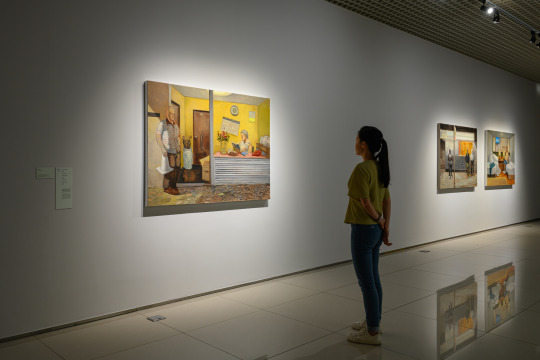
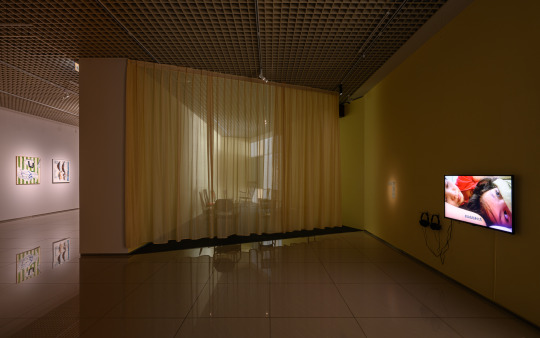




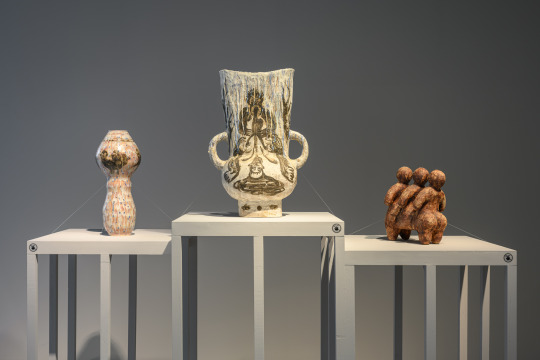



Here is where we meet
Here is where we meet
2023/06/29-10/15
Venue: Chiayi Art Museum 1F-3F
Supervisors:Ministry of Culture, Chiayi City Government
Organizers:Chiayi Art Museum, Tianmei Art Foundation
Collaborators:TKG+, Mind Set Art Center, Each Modern
Curator:Erica Yu-Wen Huang
Artists:Wang Po-Yen, Wu Chuan-Lun, Lin Yi-Hsuan, Lin Ying-Chieh, Chiu Chen-Hung, Chang Chih-Chung, Zhang Xu-Zhan, Chang Cheng-Chun, Chuang Ho, Kuo Yu-Ping, Chen I-Chun, Chen Sung-Chih, Chen Ching-Yuan, Chen Ching-Ming, Huang Chih-Cheng, Liao Chi-Yu, Liu Chih-Hung, Cheng Nung-Hsuan, Jian Yi-Hong, Lo Yi-Chun
Archive Room - Participating Artists:Ding Chien-Chung, Niu Jun-Qiang, Wang Po-Yen, Shih Meng-Hsin, Wu Chuan-Lun, Li Yi-Fan, Li Ting-Huan, Lin Hao-Bai, Lin Yi-Wei, Lin Ying-Chieh, Chiu Chen-Hung, Chiu Chien-Jen, Hung Sheng-Hsiung, Hsu Yin-Ling, Shiu Sheng-Hung, Chang Chih-Chung, Zhang Xu-Zhan, Chang Cheng-Chun, Chang San-Hsueh, Chuang Ho, Kuo I-Chen, Kuo Yu-Ping, Chen I-Chun, Chen Sung-Chih, Chen Kuan-Ying, Chen Fei-Hao, Chen Ching-Yuan, Chen Ching-Ming, Huang Chih-Cheng, Huang Xuan, Yang Han-Chiao, Liao Chi-Yu, Liao Zen-Ping, Liu Chih-Hung, Liu Feng-Ling, Cheng Nung-Hsuan, Ou Jing-Yun, Hsieh Jhou-Yu, Jhong Jiang-Ze, Lo Chan-Peng, Luo Jr-Shin, Lo Yi-Chun
1 note
·
View note
Text




Tall & Handsome Stoic Guy and his Smol & Feisty Gangster Boyfriend™
LET'S TALK ABOUT CHU (2024) episode 8
#let's talk about chu#asianlgbtqdramas#twdrama#twdramaedit#bldramaedit#jc lin#wu chien ho#go watch them!#they are on netflix!!!
105 notes
·
View notes
Text
2023 World Baseball Classic Taiwan Roster
Pitchers
#15 Yen-Ching Lu (C.T.B.C. Xiōngdì/Kaohsiung Chéngshì)
#16 Wei-Chung Wang (Wei Chuan Lóng/Taitung Xiàn)
#17 Kuan-Yu Chen (Rakuten Hóuzi/Xīn Běishì)
#21 Chen-Ch’ang Lee (C.T.B.C. Xiōngdì/Penghu)
#29 Kai-Wei Teng (Richmond Flying Squirrels/Taichung)
#32 Yu-Hsun Chen (Rakuten Hóuzi/Taipei)
#43 Chia-Hao Sung (Tohoku Rakuten Gōruden'īgurusu/Taitung Xiàn)
#58 Chih-Wei Hu (Tǒngyī Qǐyè 7-Eleven Shīzi Huì/Taichung)
#59 Kuan-Wei Chen (Wei Chuan Lóng/Taipei)
#60 Jyun-Yue Tseng (Fubon Jiānhùrén/Taipei)
#69 Tzu-Peng Huang (Rakuten Hóuzi/Kaohsiung Chéngshì)
#71 Shao-Ching Chiang (Fubon Jiānhùrén/Hualien Xiàn)
#81 Shih-Peng Chen (Fubon Jiānhùrén/Taichung Xiàn)
#93 Che-Yuan Wu (C.T.B.C. Xiōngdì/Taipei)
Catchers
#4 Kungkuan Giljegiljaw (Wei Chuan Lóng/Taichung)
#31 Dai-An Lin (Tǒngyī Qǐyè 7-ElevenShīzi Huì/Sanmin Xiāng)
#65 Yu-Chieh Kao (C.T.B.C. Xiōngdì/Taipei)
Infielders
#1 Tsung-Che Cheng (Bradenton Marauders/Pingtung Xiàn)
#5 Tzu-Wei Lin (Long Island Ducks/Kaohsiung Xiàn)
#6 Wei-Chen Wang (C.T.B.C. Xiōngdì/Taipei)
#18 Yu-Cheng Chang (Boston Red Sox/Taitung Xiàn)
#39 Nien-Ting Wu (Saitama Seibu Raionzu/Taipei)
#46 Kuo-Chen Fan (Fubon Jiānhùrén/Taichung)
#83 Li Lin (Rakuten Hóuzi/Shoufeng)
#90 Kun-Yu Chiang (C.T.B.C. Xiōngdì/Taipei)
Outfielders
#2 Tien-Hsin Kuo (Wei Chuan Lóng/Taipei)
#9 Po-Jung Wang (Hokkaido Nippon-Ham Faitāzu/Pingtung Xiàn)
#12 Chen-Wei Chen (Rakuten Hóuzi/Taipei)
#24 Chieh-Hsien Chen (Tǒngyī Qǐyè 7-Eleven Shīzi Huì/Kaohsiung Chéngshì)
#35 Chin Cheng (Rakuten Hóuzi/Taipei)
Coaches
Manager Yueh-Ping Lin (Tǒngyī Qǐyè 7-Eleven Shīzi Huì/Kaohsiung Chéngshì)
Bench/catching coach Chih-Kang Kao (Tǒngyī Qǐyè 7-Eleven Shīzi Huì/Taichung Xiàn)
Hitting coach Cheng-Min Peng (C.T.B.C. Xiōngdì/Kaohsiung Chéngshì)
Assistant hitting coach Hao-Jin Tseng (Táiwān Bàngqiú/Taipei)
Pitching coach Ming-Chieh Hsu (Rakuten Hóuzi/Kaohsiung Chéngshì)
Bullpen coach Chien-Ming Wang (C.T.B.C. Xiōngdì/Guanmiao)
1st base/outfield coach Chien-Ming Chang (Wei Chuan Lóng/Hualien Xiàn)
3rd base coach Chiang-Ho Chen (C.T.B.C. Xiōngdì/Taipei)
#Sports#Baseball#National Teams#Taiwan#Celebrities#MiLB#Richmond Flying Squirrels#Japan#Bradenton Marauders#New York#MLB#Boston Red Sox
0 notes
Text
Mass General Research Institute Could A Hormone Produced by Exercise Hold the Key to Treating Alzheimer’s Disease?, irisin and the Wrann Lab, FNDC5, Berliner Philharmoniker Aaron Copland (American, 1900–90) Fanfare for the Common Man 1942, Giuseppe Casciaro (Italian, 1861-1941), Giuseppe De Nittis (Italian, 1846–84), AN ITALIAN IMPRESSIONIST IN PARIS: GIUSEPPE DE NITTIS NOVEMBER 12, 2022–FEBRUARY 12, 2023 The Phillips Collection, Zhang Daqian (Chang Dai-chien, Chinese, 1899–1983), Wu Hufan (吴湖帆, 1894-1968), Huang Gongwang (1269–1354), Dwelling in the Fuchun Mountains (Chinese: 富春山居圖), 1348 and 1350, Huang Gongwang (1269–1354), painter, poet, and writer born at the end of the Song dynasty, Four Masters of the Yuan dynasty.
Mass General Research Institute Could A Hormone Produced by Exercise Hold the Key to Treating Alzheimer’s Disease?, irisin and the Wrann Lab, FNDC5, Berliner Philharmoniker Aaron Copland (American, 1900–90) Fanfare for the Common Man 1942, Giuseppe Casciaro (Italian, 1861-1941), Giuseppe De Nittis (Italian, 1846–84), AN ITALIAN IMPRESSIONIST IN PARIS: GIUSEPPE DE NITTIS NOVEMBER 12, 2022–FEBRUARY 12, 2023 The Phillips Collection, Zhang Daqian (Chang Dai-chien, Chinese, 1899–1983), Wu Hufan (吴湖帆, 1894-1968), Huang Gongwang (1269–1354), Dwelling in the Fuchun Mountains (Chinese: 富春山居圖), 1348 and 1350, Huang Gongwang (1269–1354), painter, poet, and writer born at the end of the Song dynasty, Four Masters of the Yuan dynasty.
https://blog.naver.com/artnouveau19/222929348155
Mass General Research Institute Could A Hormone Produced by Exercise Hold the Key to Treating Alzheimer’s Disease?, irisin and the Wrann Lab, FNDC5 Fibronectin type III domain-containing protein 5, the precursor of irisin, is a type I transmembrane glycoprotein that is encoded by the FNDC5 gene., Berliner Philharmoniker Aaron Copland (American, 1900–90) Fanfare for the Common Man 1942, Giuseppe Casciaro (Italian, 1861-1941), Capri, 1903, Sorrento, 1915, MuseoBoscoCapodimont Landscape, Path through the Thickets, Spring, 1897, ‘At the end of the century, he travelled to Paris, where he met Giuseppe De Nittis and his circle.’, Giuseppe De Nittis (Italian, 1846–84), Westminster Bridge, 1878, Breakfast in the Garden, 1884, AN ITALIAN IMPRESSIONIST IN PARIS: GIUSEPPE DE NITTIS NOVEMBER 12, 2022–FEBRUARY 12, 2023 The Phillips Collection, Walk on Lake Lucerne, Zhang Daqian (Chang Dai-chien, Chinese, 1899–1983), Temple at the Mountain Peak, 1967, Mountain Living in Autumn, 1970, Christie’s., ODE TO RED CLIFF AFTER KUNCAN, Sotheby’s CHINESE PAINTINGS – MODERN The Tales amidst Five Mountains: Mesmerizing Modern Landscape Paintings, Wu Hufan (吴湖帆, 1894-1968) Landscape 20th Century Christie’s., Shanghai Museum Layered Rocks and Dense Forest, Huang Gongwang (1269–1354), Dwelling in the Fuchun Mountains (Chinese: 富春山居圖), 1348 and 1350, ‘After passing through the hands of numerous collectors, it came to the possession of Wu Hufan (吴湖帆), painter and collector, during the 1940s. In 1956, it finally settled down in the Zhejiang Provincial Museum in Hangzhou.’, Huang Gongwang (1269–1354), painter, poet, and writer born at the end of the Song dynasty, Four Masters of the Yuan dynasty.
https://blog.naver.com/artnouveau19/222929348155
Mass General Research Institute is at Massachusetts General Hospital.
· Boston, MA, United States
In honor of November being Alzheimer's Awareness Month, this week's image of the week is Exercising the Brain with Irisin by Renhao Luo, BS!
A hormone produced during exercise, irisin, is a crucial regulator of cognitive function in exercise, aging, and Alzheimer’s disease. Interestingly, irisin binds αV/β5 integrin receptors on astrocytes, instead of neurons. This image was taken to show where irisin binds in cultured astrocytes.
Since irisin does not specifically target amyloid plaques, but rather neuroinflammation directly, we’re optimistic it could have beneficial effects on neurodegenerative diseases beyond just Alzheimer’s.
To read more about the Wrann Lab and their work with irisin, click here: https://mgriblog.org/2021/11/22/could-a-hormone-produced-by-exercise-hold-the-key-to-treating-alzheimers-disease/?fbclid=IwAR2QxcOEB5sGEutMoMUOuLET4Iy2U3RJcPSrOcfAbRPy-ywA86Ufhh_nWSA
Department: Cardiovascular Research Center
PI: Christiane Wrann, DVM, PhD
Category: A Closer Look
Equipment/scale: Nikon CSU-W1 SoRa, 20x
https://www.facebook.com/photo/?fbid=986737178932032&set=a.934885834117167
Mass General Research Institute
@MGH_RI
·
Nov 9
This week's image of the week is called Exercising the Brain with Irisin by Renhao Luo at the
@WrannLab
!
Read more about irisin and the Wrann Lab here: https://mgriblog.org/2021/11/22/could-a-hormone-produced-by-exercise-hold-the-key-to-treating-alzheimers-disease/… #Alzheimers #exercise
https://twitter.com/MGH_RI/status/1590019252186415105
Could A Hormone Produced by Exercise Hold the Key to Treating Alzheimer’s Disease?
By mghresearch | Alzheimer's Disease, Medicine | 22 November, 2021 |
https://mgriblog.org/2021/11/22/could-a-hormone-produced-by-exercise-hold-the-key-to-treating-alzheimers-disease/?fbclid=IwAR2QxcOEB5sGEutMoMUOuLET4Iy2U3RJcPSrOcfAbRPy-ywA86Ufhh_nWSA
Researchers from Mass General and colleagues have learned more about how exercise benefits brain health—insights that open a promising new approach to treating Alzheimer’s disease (AD).
In a recent study in Nature Metabolism, a team led by Mass General’s Christiane Wrann, DVM, PhD, demonstrates that it is the hormone irisin, which is produced by the muscles during exercise, that confers the positive effects of exercise on the brain.
The team also found that an injection of irisin can restore cognitive function in mouse models of Alzheimer’s disease, suggesting irisin could be effective in patients who are already displaying symptoms of the disease.
“The fact that irisin treatment was effective in AD mouse models even after the development of significant pathology is promising for translation into humans, where therapy would typically start after patients are already symptomatic,” says Wrann, an investigator at the Cardiovascular Research Center and the McCance Center for Brain Health at Mass General, and an assistant professor of medicine at Harvard Medical School.
About Irisin
Irisin, the circulating form of the membrane protein fibronectin-domain III containing 5 (FNDC5), is one of the most recently discovered in 2012 by the lab of Bruce Spiegelman, PhD, at the Dana-Farber Cancer Institute and is derived from mouse skeletal muscle.
Exercise & Irisin
Running exercise has been shown to improve spatial learning and memory, even in young mice, and is a key factor for enhancing cognitive function and the generation of new neurons in the hippocampus.
Aging & Irisin
To test how a lack of FNDC5/irisin affects mice as they age, the researchers used the novel object recognition test, a common measure of cognition.
Alzheimer's Disease & Irisin
In separate experiments using AD mice (mouse models genetically engineered to develop an inherited form of Alzheimer’s disease) the team tested the effects of irisin injections (or irisin treatment) on cognitive performance. Eight-month-old AD mice, which were already displaying the cognitive deficits of AD, received injections of a viral vector designed to increase irisin production in the liver to reach pharmacological irisin levels in plasma.
Irisin and Adult-Born Neurons
To learn how irisin affects the growth and maturation of adult born neurons in the hippocampus, the team injected both the exercised and non-exercised wild type and the KO mice with a fluorescent reporter virus.
FNDC5 Fibronectin type III domain-containing protein 5, the precursor of irisin
Fibronectin type III domain-containing protein 5, the precursor of irisin, is a type I transmembrane glycoprotein that is encoded by the FNDC5 gene.[5][6][7] Irisin is a cleaved version of FNDC5, named after the Greek messenger goddess Iris.[7]
Fibronectin domain-containing protein 5 is a membrane protein comprising a short cytoplasmic domain, a transmembrane segment, and an ectodomain consisting of a ~100 kDa fibronectin type III (FNIII) domain.
https://en.wikipedia.org/wiki/FNDC5
Berliner Philharmoniker
Born #OTD: Celebrating the life and music https://www.digitalconcerthall.com/concert/53590... of American composer Aaron Copland with his Fanfare for the Common Man. #DigitalConcertHall #AaronCopland
https://www.facebook.com/watch?v=2735579319908527
Berliner Philharmoniker
@BerlinPhil
Born #OTD: Celebrating the life and music https://www.digitalconcerthall.com/en/concert/53590?utm_medium=social&utm_source=twitter of American composer Aaron Copland with his Fanfare for the Common Man. #DigitalConcertHall #AaronCopland
https://twitter.com/BerlinPhil/status/1592112881813684224
Aaron Copland (American, 1900–90) Fanfare for the Common Man 1942
Aaron Copland (/ˈkoʊplənd/, KOHP-lənd;[1][2] November 14, 1900 – December 2, 1990) was an American composer, composition teacher, writer, and later a conductor of his own and other American music. Copland was referred to by his peers and critics as "the Dean of American Composers". The open, slowly changing harmonies in much of his music are typical of what many people consider to be the sound of American music, evoking the vast American landscape and pioneer spirit. He is best known for the works he wrote in the 1930s and 1940s in a deliberately accessible style often referred to as "populist" and which the composer labeled his "vernacular" style.[3] Works in this vein include the ballets Appalachian Spring, Billy the Kid and Rodeo, his Fanfare for the Common Man and Third Symphony. In addition to his ballets and orchestral works, he produced music in many other genres, including chamber music, vocal works, opera and film scores.
https://en.wikipedia.org/wiki/Aaron_Copland
Fanfare for the Common Man is a musical work by the American composer Aaron Copland. It was written in 1942 for the Cincinnati Symphony Orchestra under conductor Eugene Goossens and was inspired in part by a speech made earlier that year by then American Vice President Henry A. Wallace, in which Wallace proclaimed the dawning of the "Century of the Common Man".
Several alternative versions have been made and fragments of the work have appeared in many subsequent US and British cultural productions, such as in the musical scores of movies.
https://en.wikipedia.org/wiki/Fanfare_for_the_Common_Man
Giuseppe Casciaro (Italian, 1861-1941), Capri, 1903, Sorrento, 1915, MuseoBoscoCapodimont Landscape, Path through the Thickets, Spring, 1897, ‘At the end of the century, he travelled to Paris, where he met Giuseppe De Nittis and his circle.’
Christa Zaat
Giuseppe Casciaro (Italian painter) 1861 - 1941
Capri, 1903
pastel
26.4 x 31.4 cm. (10.38 x 12.38 in.)
signed, titled and dated 'GCasciaro/Capri/31 Marzo/903' (lower left)
private collection
© photo Bonhams
https://www.facebook.com/photo/?fbid=10159421178692151&set=a.10156801746067151
Casciaro was born in Ortelle, Province of Lecce, Region of Apulia. Orphaned at the age of twelve, he was raised by a paternal uncle, a priest. He was schooled in lyceum gymnasium of Maglie, where his uncle hoped he would start studies towards a career in medicine. However, there he was first instructed in art by Paolo Emilio Stasi, who aided him in enrolling in the Neapolitan Academy of Fine Arts under Morelli and Palizzi. His uncle initially thought Giuseppe was in Naples attending the university, and upon learning of his deception, ceased his support of the young man.
At the Academy, Francesco Paolo Michetti, from whom he learned to paint landscapes in pastels. Much of his life was painting landscapes of the shoreline and of his native Ortelle. At the end of the century, he travelled to Paris, where he met Giuseppe De Nittis and his circle. He gained a nomination to be professor at the Institute of Fine Arts of Urbino. He often visited and tutored members of the Royal House of Savoy about pastel painting. His works were exhibited throughout Europe and Argentina. He died in Naples in 1941.
Source: Wikipedia
Giuseppe Casciaro (Italian, 1861-1941)
Giuseppe Casciaro (March 9, 1861 – October 25, 1941) was an Italian painter, active mainly in Naples.
However, there he was first instructed in art by Paolo Emilio Stasi, who aided him in enrolling in the Neapolitan Academy of Fine Arts under Morelli and Palizzi. His uncle initially thought Giuseppe was in Naples attending the university, and upon learning of his deception, ceased his support of the young man.
At the academy, Francesco Paolo Michetti, from whom he learned to paint landscapes in pastels. Much of his life was painting landscapes of the shoreline and of his native Ortelle. At the end of the century, he travelled to Paris, where he met Giuseppe De Nittis and his circle. He gained a nomination to be professor at the Institute of Fine Arts of Urbino. He often visited and tutored members of the Royal House of Savoy about pastel painting. His works were exhibited throughout Europe and Argentina.[1] He died in Naples in 1941.
https://en.wikipedia.org/wiki/Giuseppe_Casciaro
Sorrento (1915), private collection.
https://en.wikipedia.org/wiki/Giuseppe_Casciaro#/media/File:Giuseppe_Casciaro_Sorrente.jpg
MuseoBoscoCapodimont Landscape
MuseoBoscoCapodimont
@Capodimonte_mus
# 14 marzo2021 #giornatanazionaledelpaesaggio We celebrate the National Landscape Day promoted by the Ministry of Culture with some landscape paintings from our private 19th century collection
"Landscape"
Giuseppe Casciaro
https://twitter.com/Capodimonte_mus/status/1371009955642421248
History of Painting
@TheNewPainting
·
Jan 18, 2018
The #VisualArt
Path through the Thickets, Spring - 1897
Giuseppe Casciaro
(March 9, 1861 – October 25, 1941) was an Italian painter, active mainly in Naples. ...
His works were exhibited throughout Europe and Argentina. He died in Naples in 1941.
#HistoryofPainting
https://twitter.com/TheNewPainting/status/953687749848166404
Giuseppe De Nittis (Italian, 1846–84), Westminster Bridge, 1878, Breakfast in the Garden, 1884, AN ITALIAN IMPRESSIONIST IN PARIS: GIUSEPPE DE NITTIS
NOVEMBER 12, 2022–FEBRUARY 12, 2023 The Phillips Collection, Walk on Lake Lucerne
Giuseppe De Nittis (February 25, 1846 – August 21, 1884)[1] was one of the most important Italian painters of the 19th century, whose work merges the styles of Salon art and Impressionism.
https://en.wikipedia.org/wiki/Giuseppe_De_Nittis
Westminster Bridge, 1878
https://en.wikipedia.org/wiki/Giuseppe_De_Nittis#/media/File:Westminster_Bridge_(1878)_-_De_Nittis.JPG
Breakfast in the Garden, 1884, Oil on canvas, 31 7/8 x 46 in., Pinacoteca Giuseppe De Nittis, Barletta, Italy
https://en.wikipedia.org/wiki/Giuseppe_De_Nittis#/media/File:Colazione_in_giardino.jpg
The Phillips Collection
@PhillipsMuseum
·
Nov 6
Be one of the first to see An Italian Impressionist in Paris—the first US exhibition on Gisueppe De Nittis. Reserve your ticket to the opening weekend
https://www.phillipscollection.org/event/2022-11-12-de-nittis
Giuseppe De Nittis, In the Wheat Field, 1873, Private collection
@ItalyinUS
https://twitter.com/PhillipsMuseum/status/1588924373087535111
AN ITALIAN IMPRESSIONIST IN PARIS: GIUSEPPE DE NITTIS
NOVEMBER 12, 2022–FEBRUARY 12, 2023
The Phillips Collection
https://www.phillipscollection.org/event/2022-11-12-de-nittis
aralia
@aralia_a
An unexpected canvas of the elegant man of the world, a frequenter of racecourses and boulevards, who here makes an admirable exercise in the depth of a mountain landscape ...
Giuseppe De Nittis 1846-1884
Walk on Lake Lucerne
https://twitter.com/aralia_a/status/1590772039572492303
Zhang Daqian (Chang Dai-chien, Chinese, 1899–1983), Temple at the Mountain Peak, 1967, Mountain Living in Autumn, 1970, Christie’s, ODE TO RED CLIFF AFTER KUNCAN, Sotheby’s CHINESE PAINTINGS – MODERN The Tales amidst Five Mountains: Mesmerizing Modern Landscape Paintings
Zhang Daqian (Chang Dai-chien, Chinese, 1899–1983)
Chang Dai-chien or Zhang Daqian (Chinese: 張大千; Wade–Giles: Chang Ta-ch'ien; 10 May 1899 – 2 April 1983) was one of the best-known and most prodigious Chinese artists of the twentieth century. Originally known as a guohua (traditionalist) painter, by the 1960s he was also renowned as a modern impressionist and expressionist painter. In addition, he is regarded as one of the most gifted master forgers of the twentieth century.
https://en.wikipedia.org/wiki/Chang_Dai-chien
Christie's
@ChristiesInc
·
May 26, 2021
#AuctionUpdate Zhang Daqian's 'Temple at the Mountain Peak' achieved HK$209,100,000 / US$27,062,468, the second highest price for the artist at auction.
https://twitter.com/ChristiesInc/status/1397289847002386432
Temple at the Mountain Peak by Zhang Daqian
27 April 2021
https://www.christies.com/features/Zhang-Daqian-Temple-Mountain-Peak-11626-3.aspx?sc_lang=en
Zhang Daqian (1899-1983), Temple at the Mountain Peak, dated dingwei year (1967). Hanging scroll, ink and colour on gold paper, 127.7 x 63 cm (50⅛ x 24¾ in). Estimate on request. Offered in the 20th and 21st Century Art Evening Sale on 24 May at Christie’s in Hong Kong
HKD 209,100,000
24 May 2021
ZHANG DAQIAN (1899-1983)
Temple at the Mountain Peak
Hanging scroll, ink and colour on gold paper
127.7 x 63 cm. (50 ¼ x 24 ¾ in.)
Inscribed and signed, with one seal of the artist and one dated seal of dingwei year (1967)
Dated dingwei year (1967)
https://www.christies.com/lot/lot--6321138/?from=salesummary&intobjectid=6321138&lid=1&ldp_breadcrumb=back&sc_lang=en
Christie's
@ChristiesInc
·
Mar 20, 2019
#AuctionUpdate Zhang Daqian's 'Mountain Living in Autumn' realizes $675,000, more than doubling its low estimate #AsianArtWeek https://bit.ly/2WgGTDB
https://twitter.com/ChristiesInc/status/1108036603954503680
ZHANG DAQIAN (1899-1983)
Mountain Living in Autumn
Inscribed and signed, with one seal of the artist
Dated gengxu year (1970)
Entitled by the artist on the reverse
Scroll, mounted and framed, ink and color on Japanese gold board
23 5/8 x 17 ¾ in. (58.4 x 43.2 cm.)
USD 675,000
Closed:
19 Mar 2019
https://www.christies.com/lot/lot-zhang-daqian-mountain-living-in-autumn-6193786/?from=salesummery&intObjectID=6193786&sid=f1e3be12-9b82-4696-b72a-2d615a266c0b
Zhang Daqian (Chang Dai-chien, 1899-1983)
ODE TO RED CLIFF AFTER KUNCAN
ink and color on silk, framed
56.5 by 93.3 cm. 22 1/4 by 36 3/4 in.
https://www.sothebys.com/en/auctions/ecatalogue/2019/chinese-paintings-n10114/lot.1035.html
Sotheby’s
CHINESE PAINTINGS – MODERN
The Tales amidst Five Mountains: Mesmerizing Modern Landscape Paintings
HONG KONG | 8 OCTOBER 2022
https://www.sothebys.com/en/videos/the-tales-amidst-five-mountains-mesmerizing-modern-landscape-paintings?locale=en&cmp=social____twitter_hk-fall22-fine-chi-video_29-sep-2022
Wu Hufan (吴湖帆, 1894-1968) Landscape 20th Century Christie’s., Shanghai Museum Layered Rocks and Dense Forest
WU HUFAN (1894-1968)
Landscape
Inscribed with a poem and signed, with one seal of the artist
Scroll, mounted and framed, ink and colour on paper
56.5 x 32 cm. (22 1/4 x 12 1/2 in.)
20th Century
HKD 375,000
27 May 2014
https://www.christies.com/en/lot/lot-5800178
Shanghai Museum Layered Rocks and Dense Forest
Shanghai Museum
@ShanghaiMuseum
·
May 22, 2021
Enjoy a #MuseumMomentofZen in the broad and vigorous mountains.
层岩积翠图轴 吴湖帆 (1894–1968)
Layered Rocks and Dense Forest, Wu Hufan (1894–1968)
https://twitter.com/ShanghaiMuseum/status/1396004400347365377
Huang Gongwang (1269–1354), Dwelling in the Fuchun Mountains (Chinese: 富春山居圖), 1348 and 1350, Wash painting, Paper (scroll), 31.8 × 51.4 cm (The Remaining Mountain), 33 × 636.9 cm (The Master Wuyong Scroll), Zhejiang Provincial Museum in Hangzhou., ‘After passing through the hands of numerous collectors, it came to the possession of Wu Hufan (吴湖帆), painter and collector, during the 1940s. In 1956, it finally settled down in the Zhejiang Provincial Museum in Hangzhou.’ Huang Gongwang (1269–1354), painter, poet, and writer born at the end of the Song dynasty, Four Masters of the Yuan dynasty.
Dwelling in the Fuchun Mountains and Huang Gongwang (1269–1354)
Dwelling in the Fuchun Mountains (Chinese: 富春山居圖) is one of the few surviving works by Chinese painter Huang Gongwang (1269–1354) and is considered to be among his greatest works. Painted between 1348 and 1350, the painting was burnt into two pieces in 1650. Today, one piece is kept in the Zhejiang Provincial Museum in Hangzhou, while the other piece is kept in the National Palace Museum in Taipei. Put together, the entire painting would measure 691.3 cm in length.
Separation into two parts[edit]
Wu Hongyu's nephew Wu Jing'an rescued the painting, which was however already aflame and torn into two. The smaller piece, also the beginning section, measuring 51.4 centimeters long, was subsequently known as The Remaining Mountain (剩山圖). After passing through the hands of numerous collectors, it came to the possession of Wu Hufan (吴湖帆), painter and collector, during the 1940s. In 1956, it finally settled down in the Zhejiang Provincial Museum in Hangzhou.
https://en.wikipedia.org/wiki/Dwelling_in_the_Fuchun_Mountains
Huang Gongwang (1269–1354), birth name Lu Jian (Chinese: 陸堅; pinyin: Lù Jiān), was Chinese painter, poet, and writer born at the end of the Song dynasty in Changshu, Jiangsu. He was the oldest of the "Four Masters of the Yuan dynasty".
https://en.wikipedia.org/wiki/Huang_Gongwang
0 notes
Photo
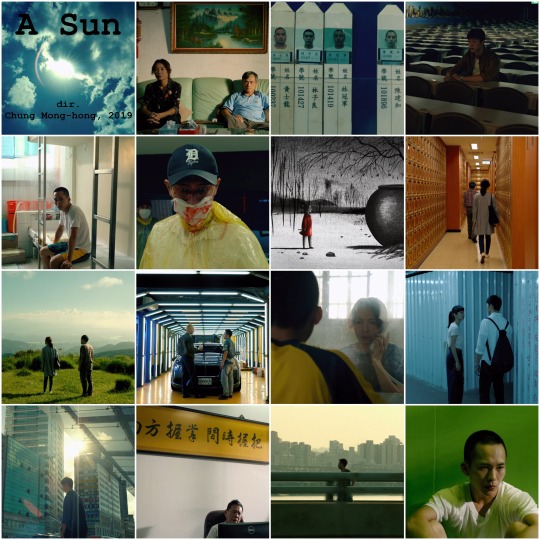
A Sun
directed by Chung Mong-hong, 2019
#A Sun#Chung Mong-hong#Nagao Nakashima#movie mosaics#Samantha Ko#Chen Yi-wen#Wu Chien-ho#Greg Hsu#Liu Kuan-ting#Apple Wu#Shao-Hua Long
9 notes
·
View notes
Text





how are you meant to accomplish your dreams if you don't dirty your hands!?
then, what about our dignity, our pride, our original goals and intentions for our dream?
between the natural hypnosis of beckoning the young to follow their dreams and passions, still unspoken, remained the dark spokes of reality, until well. you're impaled by the harshness and how cruel it can be. is the dream worth pursuing, still? how far is too far, before the line is drawn and the grip loosen? still, through gritted teeth, there is a silent remaining grit that is rooted somehow. perhaps, of youthful defiance, wanting to break free of the established norms and hierarchy. perhaps, just that of angry indignation, as if a loud shout into the abyss, for a false narrative one was told and had believed in for too long to encompass the entirety of one's worldview.
dreams are never that simple or pure! between your dreams and reality, you were always meant to compromise one or another in one way or another. you're telling me you want to give up on your dream because of your dignity?
0 notes